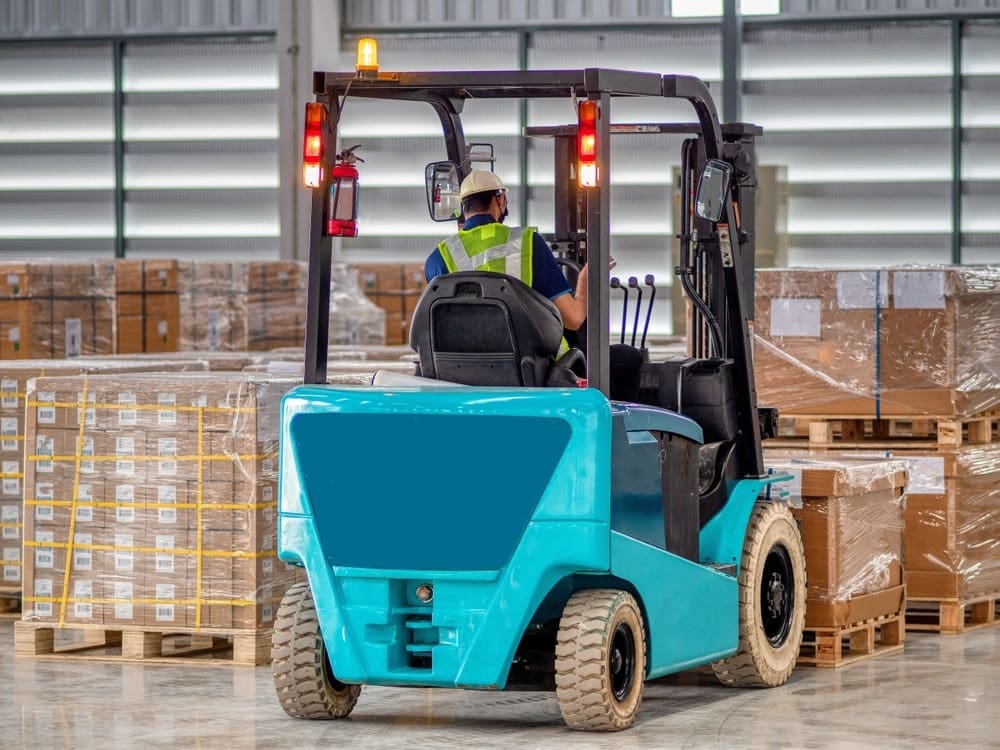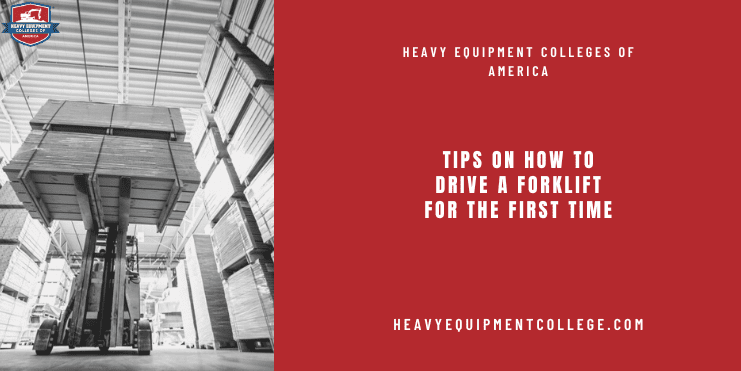Operating a forklift for the first time can feel both exciting and a little intimidating. Whether you are beginning a new career in the heavy equipment industry or adding forklift operation to your skill set, learning how to drive a forklift safely is essential. Forklifts are powerful machines designed to handle heavy loads, and they can pose risks if not operated correctly.
With the right training, preparation, and awareness, new operators can gain confidence and stay safe on the job. At Heavy Equipment Colleges of America (HEC), we’ve helped countless heavy equipment operators earn their forklift certifications. We’ll go over some basic forklift driving tips that will help keep yourself and others on the job site safe.
Table of Contents
Things First-time Forklift Drivers Should Consider
1. Understand the Importance of Training and Certification
Before you get behind the wheel, formal training is a must. OSHA requires forklift operators to be properly trained and certified, which typically involves both classroom instruction and hands-on experience.
Formal forklift training covers equipment types, workplace hazards, and operational best practices, all designed to help you work safely and efficiently.
At Heavy Equipment Colleges of America (HEC), our forklift instruction emphasizes real-world scenarios, ensuring graduates can operate confidently in various industries. Learn more about our approach to safety-focused education and why students choose HEC.
2. Prepare with the Right Attire and PPE
Wearing the correct gear isn’t just about following rules; it’s about protecting yourself from preventable accidents. Avoid loose clothing or dangling accessories that could get caught in the forklift’s moving parts.
Appropriate personal protective equipment (PPE) for forklift operators typically includes:
- Hard hat for head protection
- High-visibility vest so others can see you easily
- Steel-toe boots for foot safety
- Gloves for better grip and protection
- Safety glasses if your environment requires them
3. Conduct a Thorough Pre-Operation Inspection
A pre-shift inspection ensures your forklift is safe and ready for use. Be sure to document any issues and report them to your supervisor before using the equipment.
Before starting the engine, you will need to:
- Complete a Visual Inspection: Look for leaks, tire damage, or loose parts.
- Perform an Operational Check: Test the brakes, steering, lights, horn, and backup alarm.
- Check the Hydraulic System: Confirm there are no leaks and that the lift and tilt functions operate smoothly.
- Inspect the Load Handling Components: Inspect the forks for cracks or bends, and ensure they are securely attached.

4. Get to Know the Forklift Components and Controls
Before you start moving, take time to familiarize yourself with the machine’s layout. Locate the steering wheel, accelerator, brake pedal, and parking brake. Understand the function of each hydraulic control lever, which typically manages lifting, tilting, and side-shifting.
Most forklifts also have:
- Mast: Vertical assembly that raises and lowers the load
- Overhead Guard: Protects the operator from falling objects
- Load Backrest: Prevents materials from shifting toward the operator
Reading the operator’s manual is always recommended for model-specific features.
5. Operate Safely for the First Time
When you first drive a forklift, slow and steady wins the race. Begin in a controlled environment, ideally under the supervision of a certified instructor, before working in active job sites. Always remember that forklifts steer from the rear, which can take some getting used to.
Key safety practices include:
- Start smoothly to avoid sudden jolts that could shift the load.
- Adhere to posted speed limits and adjust speed based on surface conditions.
- Keep forks low while traveling to maintain stability.
- Use the horn at intersections, blind spots, and when approaching pedestrians.
- Avoid sharp turns when carrying a load to reduce tipping risk.
6. Be Aware of Surroundings and Common Hazards
A big part of forklift safety is constant awareness of your environment. Even experienced operators can run into trouble if they become distracted or complacent.
To stay alert and aware, forklift operators should:
- Scan ahead for people, obstacles, and changes in floor surfaces.
- Stay in open space when possible to reduce collision risk.
- Avoid driving over loose materials or wet spots that could cause slipping.
- Check for potential hazards, such as low ceilings and narrow aisles.
- Get a lay of the land before starting work in a new area.
When in doubt, stop the forklift and reassess before proceeding.

7. Final Safety Measures and Parking
When you’ve completed your work, parking correctly is just as important as operating correctly. A secure, stable parking routine helps keep both people and equipment safe.
To safely park a forklift:
- Lower the forks completely to the ground.
- Neutralize controls and set the parking brake.
- Turn off the engine and remove the key to prevent unauthorized use.
- Park in designated areas away from pedestrian walkways or active work zones.
8. Develop Confidence with Ongoing Practice & Evaluation
Forklift skills improve with repetition. Even after certification, operators should regularly review best practices and participate in refresher training. Ask experienced colleagues for feedback, practice in low-traffic areas when possible, and build your confidence gradually.
FAQ
What are the steps to operate a forklift?
Operating a forklift involves:
- Completing training and certification following OSHA standards.
- Inspecting the forklift before use.
- Starting the forklift and adjusting the seat and mirrors.
- Lifting and transporting loads while keeping the forks low during travel.
- Lowering the load before releasing it and parking the forklift safely.
Is it easy to learn how to operate a forklift?
With the right training, many new operators become comfortable quickly. While forklifts are not difficult to learn, they do require precision, focus, and adherence to safety protocols. Beginners often need time to adjust to rear-wheel steering and the machine’s weight distribution.
What are the basic rules of forklift operation?
- Never exceed the forklift’s rated load capacity.
- Keep loads balanced and secure.
- Drive at safe speeds and follow site rules.
- Always wear the required PPE.
- Be aware of pedestrians and other vehicles in the area.
Start Your Career in Heavy Equipment Industry
Learning how to drive a forklift is a step toward a rewarding career in the heavy equipment industry. At Heavy Equipment Colleges of America, we combine OSHA-compliant instruction with hands-on training to prepare you for real job site conditions.
From forklift safety to advanced heavy equipment skills, our programs help you gain the knowledge and experience employers value. We also offer other heavy equipment certification programs for tower cranes and other equipment.
Apply online today to take those first steps towards a successful career as a certified forklift operator.
Ready to Operate Heavy Equipment?
Get Certified with HEC Today!
Accelerated Programs | Multiple Locations | Job Placement Help
Open The Door To A New Career!
Start Enrollment ProcessFind The Right Location For You
